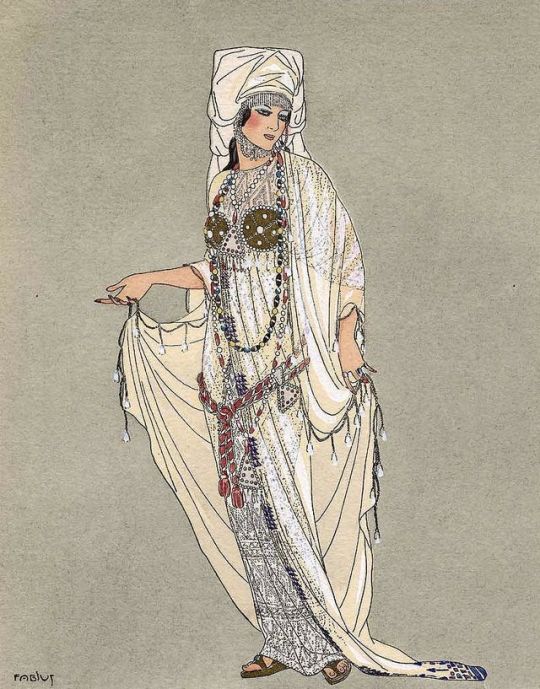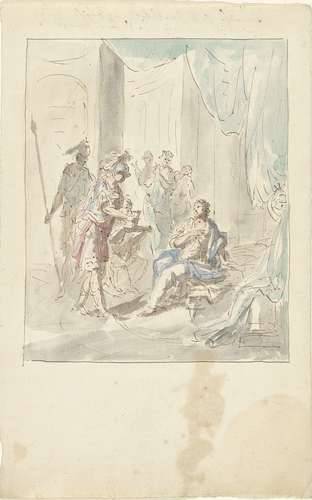#sophonisbe
Text

Sophonisbe taking the poison by Antonio Gionima
#sophonisbe#sophonisba#poison#art#carthaginian#noblewoman#second punic war#carthage#ancient carthage#antiquity#ancient rome#history#roman#mediterranean#ancient#hasdrubal gisco#antonio gionima
59 notes
·
View notes
Photo

Alberto Fabio Lorenzi, Sophonisbe (Sophonisba). Projet de costume de Worth pour Madame Bartet (Costume design for Madame Bartet in the role of Sophonisba by House of Worth), La Gazette du Bon Ton, 1913.
This project of House of Worth was executed for Mrs. Bartet in the role of Sophonisba. It consists of a large shirt in oriental tulle with a lamé of silver, half covered with an embroidered Indian veil, and a cream coat in an Indian transparent veil. The cabochons are of gold and fine pearls and the belt is a double necklace of orient.
Sophonisba (fl. 203 BC) was a Carthaginian noblewoman who lived during the Second Punic War, and the daughter of Hasdrubal Gisco Gisgonis (son of Gisco). In an act that became legendary, Sophonisba poisoned herself rather than be humiliated in a Roman triumph. (x)
#alberto fabio lorenzi#1913#house of worth#sophonisba#sophonisbe#sophoniba#costume#costume illustration#1910s costumes#1910s costume illustration#noblewoman#carthaginian#second punic war#poisoned#Madame Bartet#Anne Régina Badet#Mme Bartet#la belle epoque#belle epoque#Carthaginian costume#ancient carthage#carthage#Carthagian#carthaginian empire#charles frederick worth#lorenzi#fabius lorenzi
29 notes
·
View notes
Text
Mademoiselle Des Œillets: "this inimitable actress."
Another actress in the same generation who was not quite a star, although she played the right roles and was considered a fine actress, was Alix Faviot, Mlle Des Œillets [..]
In 1649 she was living on the rue Vieille-du-Temple, strongly suggesting that she was performing at the Marais; she was there again in 1660, when she signed the lease of the theatre. In 1662 she played the role of Viriate in Pierre Corneille's Sertorius, which opened in February to great success. Mlle Des Œillets had some sort of special connection to the play, which may have been written to feature her. In any case, Corneille wrote to the abbé de Pure on November 3, 1661, asking his opinion of the unfinished play. "I have asked Mlle Des Œillets," he writes, "who is in possession of it, to show it to you whenever you want."
[..]
Sophonisbe, starring Mlle Des Œillets, opened at the Hôtel de Bourgogne at the height of the season in January 1663. Sophonisbe was the apex of Mlle Des Œillets' career. Donneau de Visé describes her success in glowing terms:
"This role, which is the most predominant in the play, is played by Mlle Des Œillets, who is one of the premier actresses in the world, and who maintains the great reputation that she has enjoyed for a long time. I will not eulogize her, because I could not eulogize her enough. I will be content only to say that she plays this role divinely, better than can be imagined; that M. Corneille has to be obliged to her for it, and that if you go to see this play only to see this inimitable actress, you will leave completely satisfied."
We can conclude that Mlle Des Œillets had many of the attributes of a star: audiences were advised to see her whatever the vehicle, and an important playwright wrote roles for her. She also appears to have been empowered through her connection to Corneille. And she was a very god actress. On the other hand, she was not especially beautiful or sexually alluring, and she was not a celebrity. She was a Meryl Streep and not a Marilyn Monroe.
Georges Forestier, in his biography of Racine, makes a compelling argument that Mlle Du Parc, the beautiful celebrity actress who played the role of Andromaque, which was written for her, was far less accomplished on stage than Mlle Des Œillets, who played Hermione. "The character of Andromaque", he proposes
"is relatively uniform; everything is lamentation. While the great role, the role with multiple facets, alternating the grandeur of a princess and the innocence of a young girl, tears and haughty irony, the abasement of love and at the last destructive vehemence, in short the role that, as one said in the seventeenth century, would "faire le brouhaha dans la salle" [that is, "bring down the house"] was that of Hermione. And rightly, the character of Hermione went to Mlle Des Œillets, the great tragic actress."
The death of Mlle Du Parc in 1668 [..] was a sensational scandal; the death of Mlle Des Œillets two years later was a loss to the theatre and a cause for grief, but her funeral was not a mob scene, nor did a handsome young playwright hang, half dead, over her coffin. [..]
In other words, although a great actress with a wonderful voice, Mlle Des Œillets was not seductive. Nor was she an object of scandal. Her biographers reports no evidence of any "adventures" on her part, although she was widowed for more than twenty years.
Virginia Scott- Women on the Stage in Early Modern France: 1540-1750.
#xvii#virginia scott#women on the stage in early modern france#alix faviot#mademoiselle des œillets#pierre corneille#jean racine#mademoiselle du parc#play: andromaque#play: sophonisbe
3 notes
·
View notes
Text
Una visita poco recurrente
El 1 de agosto de 2022 hacían su entrada al puerto de Barcelona los patrulleros Jugurtha (P-610) y Sophonisbe (P-613) de la Armada de Túnez. Quedaron atracados en el Muelle de Barcelona paramento norte junto al World Trade Center y allí permanecieron hasta el día 5 de agosto.
Patrulleros tunecinos atracados en el Muelle de Barcelona.
No es habitual ver buques de guerra tunecinos en el puerto de…

View On WordPress
#2022#Armada de Túnez#Jugurtha (P-610)#MSOPV 1400#OPV#patrullero oceánico#Puerto de Barcelona#Sophonisbe (P-613)
0 notes
Text
0 notes
Photo

GEORGE PENCZ
‘Sophonisbe leert den Giftbecher’
(Sophonisba empties the poison cup)
16th c.
20 notes
·
View notes
Photo

Sophonisbe, Heinrich Aldegrever, 16??, Finnish National Gallery
http://kokoelmat.fng.fi/app?si=RAMSAY+46
2 notes
·
View notes
Photo

(hanoi)
« Sophonisbe écouta ce message et prit le poison des mains de l’esclave : « J’accepte, dit-elle, ce présent de noces ; et je l’accepte avec reconnaissance, si c’est là tout ce que mon époux peut faire pour sa femme. Dis-lui pourtant que la mort m’eût été plus douce, si le jour de mon hymen n’avait pas été le jour de mes funérailles. » »
( Tite-Live: Histoire romaine )
My portfolio: RECLAMATION
25 notes
·
View notes
Photo

Sophonisbe Dress:
Hey guys, here’s my SIMBLREEN 2019 GIFT #2.
Info and Download HERE.
⧫ Donate ⧫
1K notes
·
View notes
Photo

Masinissa reikt Sophonisbe de gifbeker, Museum of the Netherlands
Ontwerp voor een schildering.
http://hdl.handle.net/10934/RM0001.COLLECT.232705
1 note
·
View note
Audio
(Daniel De Sol)
Stern⭐cast by Aimã
https://soundcloud.com/danieldesol/sterncast-038-by-aima
ist ein musikalisches Projekt, das Ahnenmelodien mit moderner Elektronik mischt. Dieser organische Klang fängt die Schönheit der verschiedenen Kulturen der Erde ein, in denen Musik Teil des spirituellen Prozesses des Erweckens des Heiligen ist. Laden Sie zu einer Erfahrung der Selbstbeobachtung ein und lassen Sie Ihre Gedanken durch Tanz los.
✉️ Kontakt E-Mail [email protected]
Soundcloud: @aimadj
Homepage: https://linktr.ee/fernandoyakecan
Instagram: https://www.instagram.com/fernandoyakecan
Playlist:
Manucho Ft. Barbie Williams - Sea Urchin
Hot Oasis - Wadi Tarabin
Jota Karloza - Om Kleem
AIWAA - Infinity Eyes
Sangeet - Sufis in Candolim
Dj Khaikhan - Urfa`nin Etrafi Dumanli Daglar
Sangeet - Govinda Hare
Baldo - Ehran
Mansoor Hassan - Spoken Lies
Jugurtha - Sophonisbe (Sahalé Remix)
Epstein - Ilahi
Laroz Camel Rider - Zurna
Dark Sova - Inane
Mansoor Hassan - Introversion
José Solano - Ocha
Los Cabra, Christ Burstein, Manuel Sahagun - Yamuna
Aroma (IND) - Lal Qila
.
.
#KombinatSternradio #Ethnic #Shamanic #Organic #Soundscape #Deephouse #Downtempo #Techhouse #Techno #Slow #DanielDeSol #DeepTribal #downtempo #music #electronica #ambient #chillout #techno #deephouse #housemusic #dj
1 note
·
View note
Photo

Created by Nords
Sophonisbe Dress
DOWNLOAD TSR
12 notes
·
View notes
Text
Madeleine Béjart: "the best actress of all."
Madeleine Béjart came very close to being a star, if only she had stayed in Paris and if she had been less attached to the star of Molière. She was undoubtedly a very fine actress in both comedy and tragedy, but especially in tragedy, which could have set her apart had she remained in Paris during the time that tragedy was being reintroduced into the French theatre. Furthermore, she was connected to both la galanterie and Le Parnasse. She is described in Georges (and Madeleine) de Scudéry's Almahide, published in 1660-3:
"She was beautiful, she was galante, she sang well, she danced well, she played all sorts of instruments, she wrote very prettily in verse and in prose and her conversation was very diverting. She was one of the best actresses of her century and her acting had the power to inspire in reality all the feigned passions that one sees represented on the stage. This agreeable actress was called Jebar and, as Abindarrays sought to divert himself and efface the memory of past adventures, he went to the theatre where he saw her play the role of Sophonisbe in a manner so touching and so passionate that first he admired her and then he loved her; first his heart was tender with pity, then she stole it from him."
Galante is a curious word with a certain built-in equivocation. On the one hand, it implies elegance and grace in language and in society; on the other, it suggests a libertine life style. A galant homme or galante femme is "respectable, civil, sociable, of agreeable conversation", and someone who is professionally competent, who "has judgment". On the other hand, a femme galante is a coquette, and la galanterie is what is delicately glossed as le commerce amoureux.
Mlle Béjart's early life seems to accomodate both meanings […]
In any case, by June 1643, when she, her brother Joseph, her sister Geneviève, and seven others, including the young Jean-Baptiste Poquelin, founded the ill-fated Illustre Théâtre, she was their star, the only troupe member granted the right by contract to choose any role she liked. With the failure of the Illustre Théâtre, Madeleine Béjart and M. Poquelin, the newly self-christened Molière, joined the troupe of Charles Dufresne which was sponsored by the duc d'Epernon, the governor of Guyenne and Gascogne, a vast area in southwestern France. The playwright Jean Magnon dedicated his newest play to Epernon, thanking him for his "rescue" of Mlle Béjart, "the most unhappy and one of the most worthy actresses of France… You have taken that unfortunate woman from a precipice where her merit had cast her, and you have restored to the stage one of the most beautiful characters that it has ever borne." The actress had starred as the concubine Aspasia in Magnon's Artaxerxe at the Illustre Théâtre.
Unfortunately, Mlle Béjart and Molière were to remain out of Paris for fourteen years, long enough for her to miss the opportunity to become the first great Parisian star. By the time they returned, in 1658, she was 40 and the leading tragic actress of a troupe that did not play tragedy well and that was about to become famous for comedy […]
In 1669 Saint-Evremond wrote to Anne Hervart that "we have here some Actors rather good in comedy, detestable in tragedy, with the exception of one very good Actress in everything. They have performed Tartuffe." This would appear to be a reference to Mlle Béjart, who played Dorine, but who continued to appear in tragedy. At least, her penchant for tragedy might be one reason the troupe at the Palais-Royal continued to offer a tragic repertory, even though it was hardly a money-maker. Madeleine Béjart, who had given her whole professional life to this troupe, deserved some small recompense, even if it was only the chance to play some of her great roles from time to time.
[..]
Still, no matter how generous the troupe may have been in offering Mlle Béjart the occasional chance to play her favorite tragic queens, she is still remembered as Molière's mistress-helpmate and as an actress who specialized in comic servantes and suivantes. The gazetteers paid very little attention to her compared with the tall, beautiful Mlle Du Parc and the seductive Mlle Molière. Tallement des Réaux reports that rumor had it that "she was the best actress of all", although he has never seen her play […]
All the elements were in place to make Madeleine Béjart the first star of the French theatre: talent, beauty, and mild notoriety. The timing, however, was off, the troupe was a bad fit, and her image as Molière's mistress discarded for her own daughter created the wrong kind of scandal. It was her daughter who would reap the rewards of that.
Virginia Scott- Women on the Stage in Early Modern France: 1540-1750.

Found on the Internet, originally from Twitter @peanutMGA, after some research I think it's yours, @le-roi-des-bulgares
Molière and Madeleine Béjart
17 notes
·
View notes
Text
De son vivant Massinissa a toujours été un loyal allié de Rome, participant à l’effort de guerre en envoyant des armées soutenir nos cousins méditerranéens en Europe et en Asie. Même après sa mort ses successeurs continuèrent de soutenir Rome pour la simple raison que la Méditerranée est une famille qui lutte pour un même idéal civilisationnel, d’ailleurs c’est en Hellénie (Grèce) qu’il enverra ses fils faire leurs études et la langue hellène et romaine furent parlé dans son royaume en plus du libyen et du punique. Malheureusement les historiens de l’histoire officiel n’arrivent pas à concevoir l’idée que fut un temps où les Atlantes (Maghrébins) aimaient les Romains et les Hellènes, pour eux nous restons de façon caricaturale lié à l’Orient et donc forcément ami des Puniques (Orientaux) comme nous le serions des Arabes aujourd’hui. Tout ceci est un regard néocolonial sur l’histoire de la Numidie de Massinissa, car bien au contraire, c’était un Roi déterminé à libérer l’Afrique (Tunisie) de la colonisation et de la domination phénicienne (orientale). Les Carthaginois à l’instar de leur héritier arabo-musulmans qui ont fondé Kairwan sont de nature perfide et ont sentis le vent tourné, la main de Sophonisbe fut donné à Massinissa pour calmer ses velléités patriotiques. Nous connaissons tous la célèbre phrase prononcé par Massinissa qui dit : “l’Afrique aux Africains”, elle témoigne d’une profonde volonté anti-punique et non d’un esprit anti-romain comme le laisse à penser les historiens mystificateurs. La fin de son règne sera marqué par la guerre contre les Phéniciens et la volonté de reprendre l’Afrique (Tunisie) aux Orientaux, cependant son combat contre l’occupant “sémite” n’était pas guidé par une haine raciale, mais politique, puisque lui même aimait Sophonisbe et a donné des noms phéniciens à ses enfants, sans oublier que le punique était la langue d’état dans sa cour royale. En d’autre terme Massinissa fut un génie stratégique et civilisationnelle, il savait parfaitement faire la différence entre ses sentiments et les intérêts de son peuple. Bien sur il ne cautionna pas pour autant la destruction de sa culture par les Carthaginois et rétablit rapidement les usages et les coutumes libyques de ses ancêtres après 800 ans d’occupation phénicienne, il tira son peuple du chaos instauré par l’occupant et les encouragea a revenire vers les villes et cultiver.
D’autres exemple comme Maysara le tingérois porteur d’eau devenu Roi et qui chassa les Arabes de l’Atlantide sont à mettre en parallèle avec Massinissa même si ce dernier n’a pas abolis la religion de l’occupant, il permit néanmoins à plusieurs peuples et tribus libyennes de préserver leurs cultes et usages menacé par l’occupation arabe. La reconquête des terres libyennes par Maysara jusqu’aux portes de l’Egypte obligea les Arabes a voire une attitude beaucoup plus diplomatique pour amadouer les velléités patriotiques du souverain libyen et de ses armées de révoltés. La trêve permit aux armées caliphales arabes de se reconstituer et de redevenir une menace future après la mystérieuse mort (assassinat) de Maysara. Il en est de même pour Massinissa fut amadoué par son mariage avec Sophonisbe, alors qu’il pouvait conquérir Carthage et mourut mystérieusement avant d’avoir pu aboutir sa reconquête des terres libyennes.
Aujourd’hui nous devons démystifier notre histoire et sortir du regard néocolonial caricatural du numide ennemi de Rome, car bien au contraire nos peuples ont bien plus en commun avec Rome qu’avec Carthage ou Damas, une relecture aux allures révisionnistes est plus que nécessaire à la compression de ce que nous sommes et de ce qu’on été nos héros de la reconquête, que ce fut Maysara ou Massinissa.
Ce qui est aujourd’hui scandaleux c’est d’entendre les descendants de numides aimer Carthage (colonie orientale), Hannibal et se réclamer de Massinissa, c’est en quelque sorte comme aimer la Shoah, Hitler et se réclamer de Theodor Herlz. Pire encore, nous sommes face à un syncrétisme politique avec l’arrivée du mouvement néopunique (amazirisme) qui n’a pas démérité son nom et qui considère l’occupant phénicien comme étant autochtone (càd libyen) et les Cananéens (Phéniciens) comme leurs ancêtres par le Roi cananéen (palestinien) Mazigh, d’où la terminologie hébraïque de “Am-Mazigh” (en hébreu : “peuple de Mazigh”). Non seulement il y a là une grave erreur idéologique, puisque nous le savons, Carthage était l’ennemi des Africains et des Libyens en général, mais l’identité défendu par Massinissa a été abandonné au profit d’une origine biblique orientale qui rejoint celle des Carthaginois et que combattait nos ancêtres.
Une chose est sur, le mouvement néopunique pro-carthage et levantin amazir a trahis le combat de Massinissa et utilise son image pour asseoir leur propagande éhontée. Massinissa qui c’est battu pour défendre l’identité libyenne des autochtones a finalement été détourné et utilisé comme un personnage punique opposé à Rome et anti-romain, rien que de voir ça notre Héro doit se retourner dans sa tombe.
Cependant nous pouvons rétablir la vérité historique, le rôle et l’identité de Massinissa ainsi que son alphabet, car pendant que nous parlons du “tifinagh”, nous abandonnons l’alphabet africain utilisé sous son règne et retrouvé dans les ruines antiques de Daugga au nord de la Tritonie. Ce n’est qu’une question de volonté et de moyen, cependant pour y arriver, le mouvement néopunique doit disparaître.
Brûlons le néopunisme !
Massinissa l’allier de Rome contre Carthage De son vivant Massinissa a toujours été un loyal allié de Rome, participant à l'effort de guerre en envoyant des armées soutenir nos cousins méditerranéens en Europe et en Asie.
#Africains#Afrique#Carthage#Hellènes#Massinissa#Néopuniques#Numides#Puniques#Romains#Rome#Sophonisbe#Tritonie#Tunisie
0 notes
Photo

6/100 days of productivity
Summarizing Sophonisme and I'm in love with this play. Sophonisbe is such an awesome character.
My parents spent the entire afternoon screaming after my little sister who didn't prepared her exams and now they are still screaming for no reason. It's so stressfull, I'm tired of this. I will make some hot chocolate before going to bed uhuhu.
2 notes
·
View notes